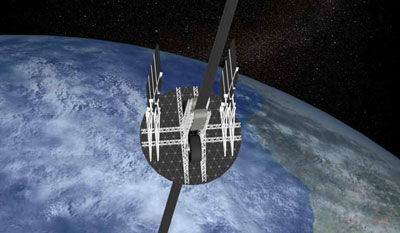Space elevator dry run: next stop, the Moonby Sam Dinkin
|
| A lunar elevator would not have to have as strong a cable as the Earthvator. |
The cable has to support its own weight so if that weight is one-sixth as much, we may be down to a required tensile strength of 20 gigapascals (GPa) which is less than a third of the measured value of a singlewalled nanotube and about a fifteenth of the theorized maximum tensile strength of CNT. There would still have to be a good deal of material science because 20 GPa is a good bit better than our best tubes, but that's less than one-sixth as much work as Earthvator.
The cost of a lunar elevator (Lunavator) would be less than Earthvator. R&D cost would be lower because of lower cost material to develop with lower tensile strength. Material cost would be higher because the material for the bulk of the elevator would have to be gathered on the Moon or sent to L-1. We might have to find a carbonaceous chondrite asteroid to anchor the elevator and provide grist for the mill to spin out nanotubes. There ought to be some carbon asteroid strikes on the Moon to go with the metal asteroids that Dennis Wingo is so proud of (see “Review: Moonrush”, The Space Review, August 16, 2004) so it might not be such a terrible prospect to use lunar carbon. Lunavator will not have to be treated with more than one kind of treatment, just anti-radiation treatment. Earthvator has to worry about wind and lightning and many other terrestrial hazards that Lunavator will not.
| Getting the price of Moon to L-1 down to the cost of lunar electricity would be quite a coup for lunar tourism. |
I had the idea that the lunar elevator could actually be a mechanical elevator with mechanical transmission of the elevator energy because taper would be less important on the Moon than on Earth. That is, there would be moving cable and pulley. Someone else had the same idea. Instead of the power projection idea for climbers that Edwards favors for Earthvator, there could be a nuclear power plant or a large solar array on the Moon. As long as we are stringing CNT up to L-1, we might as well have a lunar power grid. The grid would not need to be half way around the Moon. Just stretching the grid to a pole would enable full time sunlight at the other end. The polar solar arrays will be nearly twice as efficient as the equatorial ones because there are sites that stay sunny nearly all the time. Solar at lower latitudes could work nearly as well with circumpolar train tracks for a “solar train” that makes a circuit once a month. There would still need to be moving elevators on the lunar cable for express traffic. Who wants to spend three days on a lunar elevator, when you can speed on down?
Getting the price of Moon to L-1 down to the cost of lunar electricity would be quite a coup for lunar tourism. With Earth to L-1 not much more expensive than Earth to orbit, lunar tourism may be more popular than orbital tourism even though it will be more costly at first. Once lunar industry and power production gets going (and lunar polar water cracking for hydroponics and humidity), the Moon may be a cheaper hotel destination for an extended stay than Earth orbit.
A Lunavator can also help spawn an Earthvator and space elevators for Mars, Titan, and a bunch of other destinations. It would take a carbonaceous chondrite or two to get the carbon to the elevator factory, but in the end we would have another elevator ready to go. So the Lunavator can say to Earthvator, “I am your father, call me Lu.”
